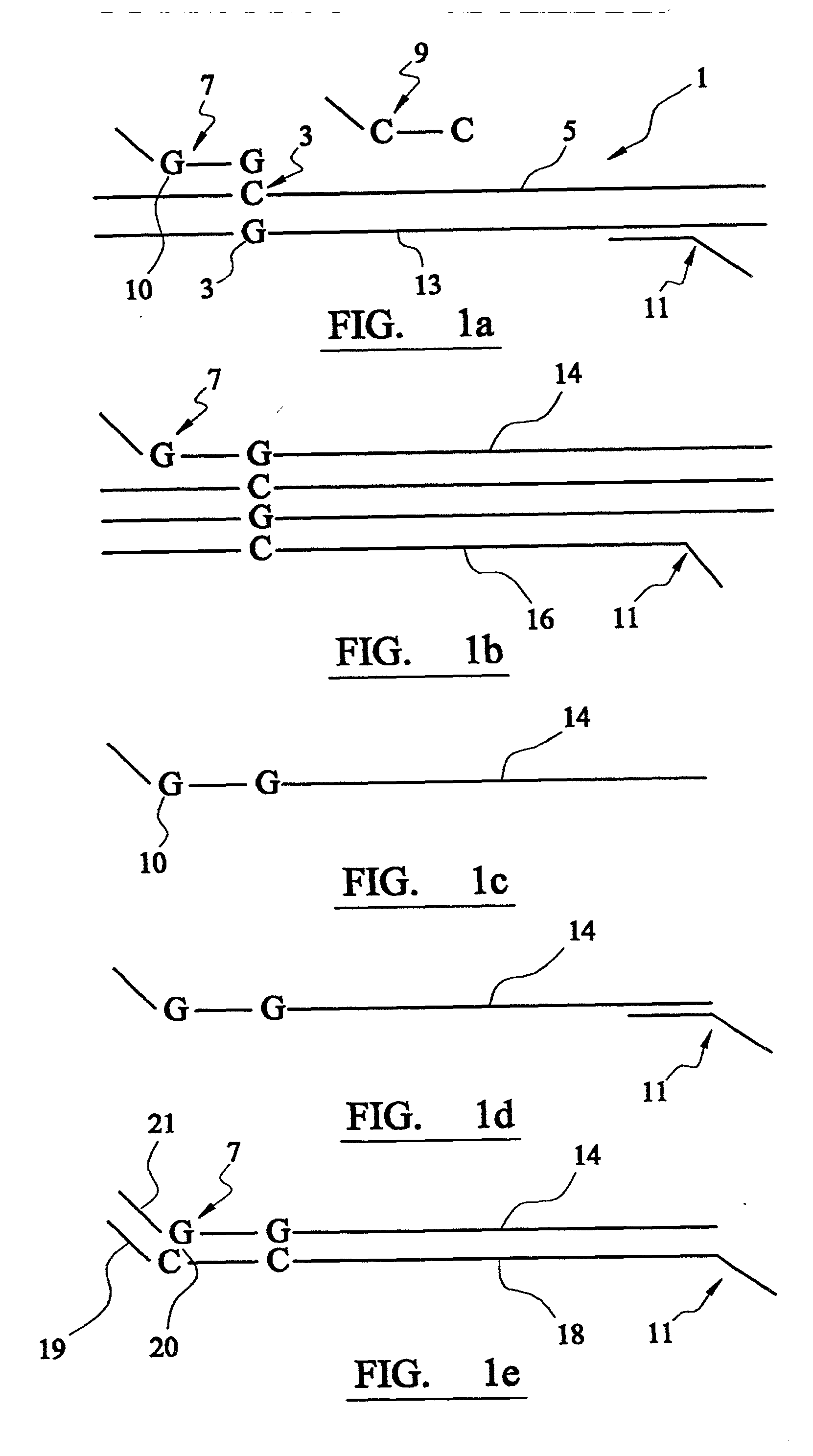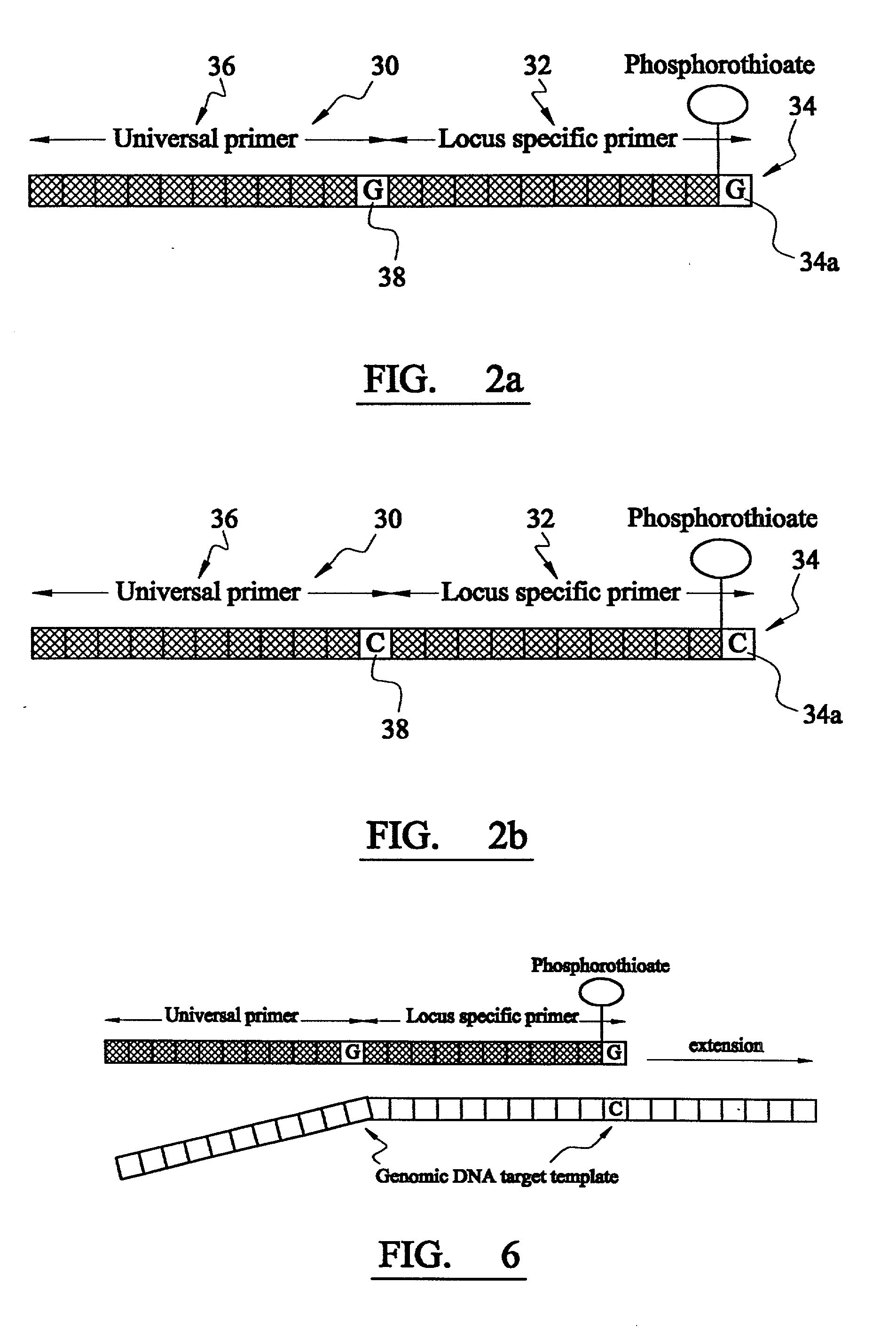Analysis of DNA
- Summary
- Abstract
- Description
- Claims
- Application Information
AI Technical Summary
Benefits of technology
Problems solved by technology
Method used
Image
Examples
example 1
[0258] Multiplexed Mitochondrial DNA
[0259] Reaction Conditions:
[0260] DNTPs all at 10 mM;
[0261] Final concentration of 35 mM. PE buffer 15 mM 15 mM MgCl2 per reaction MgCl2=0.375 mM. AmpliTaq=0.25 ul in 50 ul
[0262] In the following example, 1 uM of each of the forward primers and 2 uM of the reverse primer listed in table 4 was used in the reaction mixture. A 50 ul reaction containing 0.3 ng of genomic DNA was amplified through 8 cycles at 94C for 30sce; 57C for 30 sec and 72C for 90 sec. An aliquot of 5 ul of the reactant was then transferred into a second tube containing 1 uM of each forward universal primer and 1 uM of the reverse universal primer. This was amplified for 22 cycles at 94C for 30 sec, 62C for 30 sec and 72C for 90 sec. Samples were electrophoresed on a ABD 377 automated sequencer with Rox 500 sizing standard. The negative control was treated under the same conditions, except that no DNA was added to the reaction.
[0263] The results are illustrated for the four sampl...
example 2
[0264] Elucidation of a Mixture Where the Minor Component is <10 pu DNA (Genomic Equivalent).
[0265] In the next example, the results for which are illustrated in FIG. Y2, mixtures were prepared with the major component coding for the mt0073A polymorphism (2 ng genomic DNA) and the minor component coding for the mt00326 polymorphism (0-50 pg). Amplified with forward primers, either mt0073-G or mt0073-A (1 uM) and the reverse primer mt00326 (1 uM), the cycling conditions were the same as described previously but the second round amplification was just 3 cycles.
[0266] In the first experiments, left hand series, (a) primers used were mt0073-G (1 uM) and mt00326 (1 uM) whereas in experiments, right hand series, (b) primers were mt0073-A (1 uM) and mt00326 (1 uM). The results (a) showed that even in the presence of very great excess of mt0073-G template, there was no mt0073-A background product detected. Similarly, in experiment (b) using just primer m00073A there was no mt0073-G detected...
example 3
[0268] Genomic DNA--Group Specific Component (Gc)
[0269] The Ge single nucleotide polymorphisms have been well characterised (Braun et al, 1992) Hum Eanet, 89:401-406. In addition a large number of rare variants have been identified--the test described here only detects the common alleles--Gc 2, GcIF and Gcl S. Reynolds and Sensabaugh (1990) in Polesby et al (eds) Advances in Forensic Haemogentics, Vol. 3 Springer, Berlin, Heidelburg, New York pp 158-161 compared cDNA sequences of Yang et al (1985) Pioc-Nat-Accad-Sci USA 82:7994-7998 and Cooke N. E. and David E. V. (1985) Serum D-binding protein is a 3.sup.rd member of the albumin and alpha-feto protein gene family, J. Clin. Invest. Vol. 76 pg. 2420-2429. Although polymorphisms were observed at 4 different sites, the most informative are at codons 416 and 420, where single base changes result in an amino acid change. At triple 416, GAT codes for an aspartic acid residue in the Gc2 and Gc1F phenotypes, whereas GC1S has a glutamic acid...
PUM
| Property | Measurement | Unit |
|---|---|---|
| Fraction | aaaaa | aaaaa |
| Fraction | aaaaa | aaaaa |
| Time | aaaaa | aaaaa |
Abstract
Description
Claims
Application Information
 Login to View More
Login to View More - R&D
- Intellectual Property
- Life Sciences
- Materials
- Tech Scout
- Unparalleled Data Quality
- Higher Quality Content
- 60% Fewer Hallucinations
Browse by: Latest US Patents, China's latest patents, Technical Efficacy Thesaurus, Application Domain, Technology Topic, Popular Technical Reports.
© 2025 PatSnap. All rights reserved.Legal|Privacy policy|Modern Slavery Act Transparency Statement|Sitemap|About US| Contact US: help@patsnap.com



